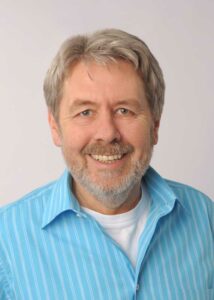Inner wisdom and the longing for liberation
Author: Dr. Sylvester Walch
For the spiritual traditions and transpersonal psychology, we are far more than the personal-individual self that has continuously emerged throughout life. This cosmic self goes beyond the limited horizon of our individual personality. It is transpersonal and connects us to the great mystery. In this process, consciousness-expanding practices such as meditation and holotropic breathing can support us. There we can find and cultivate access to our Inner Wisdom.
If human beings listened to their inner voice they can count on guidance in their development. It reaches deeper than we can comprehend, and it encompasses more than we can imagine. We can trust that we can make the best of our lives if we follow these “messages of being”. They are creative, innovative and transformative, and those who engage with them feel more alive, more true and more in tune with themselves and the world. This inner leadership, which can also be called “self-leadership,” not only takes into account the existing potentials, but also always includes the external conditions.
MODERN MEDICINE AND ALTERNATIVE HEALING METHODS
In medicine, it is now undisputed that “every healing is always and fundamentally self-healing” (Hüther, 2012, p. 422). Of course, how effectively the self-healing forces work always depends on the patient. Whether he or her understands his or her disease occurrence in a larger context of meaning. Also the active participation in his or her healing, and if he or her is able to build a positive attitude toward the recovery process. As soon as the brain, which controls the complex human organism, notices that something is out of balance, it activates the self-healing forces (Hüther, 2012).
Just as the body initiates healing processes on its own, the soul and spirit are also constantly striving for balance, growth, and realization.
The view that doctors, therapists, and spiritual guides are all about building a trusting milieu in which healing and development can take place is observed in alternative healing modalities. Especially in holistic consciousness-expanding pathways.
From this élan vital (Bergson, 2013), as we can also call these inner forces of order, also springs that source of inspiration and healing to which the Holotropic Breathwork method fundamentally refers. An Inner Wisdom to which we can entrust ourselves always and in every situation, but especially in profound healing processes. Already in one of the first sessions with Stanislav Grof, my esteemed teacher, this was impressively brought home to me by a key experience.
A group participant fell into an extreme state. She shook all over for hours, repeatedly emitted terrible cries, and shook as if by waves of energy. Around one o’clock in the morning, when the other group members had long since left the group room and I was still sitting next to her alone with Stan, the movements gradually ebbed away, her body relaxed more and more, and suddenly deep peace returned. Stan Grof brought her tea. She drank it, smiled and said, “Thank you for staying with me. I am happy and full of love!” What is always aptly expressed in wisdom sayings occurred:
When we are truly present where we are, we make peace.
WHAT SHAPES OUR SELF?
However, it should be mentioned here already, that the self is more than the sum of its internalized experiences. Because even the earliest life experiences do not encounter a tabula rasa, but an inner resonant membrane, which has always organized the impulses encountered. Brain research (Singer, 2006) also speaks of emergent qualities of a self-organizing process. This one leads to coherent perceptions and to coordinated behavior. Very similar to chaos research (Lucadou, 1995), which assumes self-emerging principles of order (dissipative structures). The process of differentiation and integration on which our individuality is built begins long before birth. However, since the embryo still experiences a certain protection by nature through the boundary of the mother’s womb, the newborn is extremely receptive and sensitive. Especially in the first years when it is still unconditionally at the mercy of the environment.
Ideally, a child is unconditionally loved and valued so that a stable sense of self and worth can be built.
(Walach, 2000)
Through early experiences of violence, basal deficits of security, or chronic conflict in the family, the developing self contracts and creates a facade that protects against the threatening world. An illusory personality behind which it can retreat. The inner ground is thereby perceived as fragile and unstable. One cannot find a foothold even within oneself.
Clinical psychotherapy knows that severe mental disorders often stem from a wounded self.
Those who were constantly devalued by their parents may be confronted with deep fears when they make decisions or want to go their own way. People affected by this experience themselves as cut off from life. Empty inside, and yet driven by constant worry and fear. Therefore, the ability to experience and communicate love is withering. This increases the condition.
THE HIGHER SELF IN YOU AND IN ME
An awareness that man represents the divine has been preserved in the mysticism of all great religious traditions. Christianity says: “The kingdom of God is within you”. Buddhism: “Look within, you are the Buddha”. Siddha Yoga: “God dwells within you as you”. Hinduism: “Atman (the individual consciousness) and Brahman (the universal consciousness) are one”. Islam: “He who knows himself knows his Lord”.
So we can discover this source of origin of our identity in ourselves. Nevertheless without being able to grasp it sufficiently with our conventional terms and concepts. It can be experienced, however, in the manifestations of its immediate presence. Be it as the experience of an inner light, as the awareness of a comprehensive connectedness, or as an overflowing fullness of grace. It is the vibrating energy that trickles through the human being in extraordinary moments. The gleam in the eyes, the electrifying touch and the light behind the heart. It is like an inner smile full of goodness and love. That light shines through everything.
The universal Self shines ceaselessly in all living beings, in nature and in the cosmos, in different forms and colors.
Everyone experiences it differently, and yet it is one substance. Whoever experiences it in himself, suddenly recognizes it not only as his own core. It is also in every human being, everywhere you look. Once in meditation I experienced myself as if enveloped by a blue glowing cone of light, which then contracted into a tiny pearl. Afterwards, I saw the globe from the outside. I saw all people connected by a purple ribbon.
 Transpersonal Self Inner wisdom and the longing for liberation© Adobe Photostock
Transpersonal Self Inner wisdom and the longing for liberation© Adobe Photostock
The universal self is within and beyond the manifoldness of life, pulsing through everything. It does not seem born, nor does it seem mortal. It encompasses the impermanent and the eternal, the finite and the infinite. For Muktananda (1987, p. 41), drawing on the Upanishads, it resides forever in the heart of all human beings. “[…] Smaller than the smallest and greater than the greatest.” The higher Self actualizes itself in the timeless Light that exists in every particle. In Om that vibrates in every cell. In the Holy Spirit that permeates everything. The Self, as the center of the individual, is inseparable from the cosmic order.
Universals are, just like a hologram, imbedded into us.
So that our deepest inner being can always connect with the boundless and formless. The personal self has to be suspended within it, in a double sense, both embedded and transcended. Through its innermost being, everyone communicates with the totality of the All-One. At this interface we find the wisdoms and keys of life. This Inner Wisdom is always there for us, strengthening, inspiring and healing. In good days and bad. It knows more than we can know. It reaches deeper than we can comprehend. For example, anyone who has a difficult task ahead of them, is in crisis, or has an existential question to answer, can consciously connect with this source for help.
THE PATH OF THE SEEKER TO THE TRANSPERSONAL SELF
Different psychotherapeutic directions, spiritual schools and also brain research thus assume that a fundamental impulse for outer as well as inner development is inherent in the human being. Interestingly, it is often trivialities or chance encounters that are the final deciding factor in which path seekers then take. Thus a place in a self-experience group with Stanislav Grof was unexpectedly made possible for me by the fact that I had been sitting at the lunch table. With a woman I did not know. She had to cancel her participation in this seminar at short notice. What went to motion after the earlier mentioned impressive experience of the accidental visit of Stanislav Grof’s lecture in Salzburg, found its concretization through this encounter. Besides these synchronistic manifestations of implicit motives, conscious intentions and decisions of course also play an important role when and how someone decides for a path to wholeness.
 Transpersonal self Inner wisdom and the longing for liberation© Adobe Photostock
Transpersonal self Inner wisdom and the longing for liberation© Adobe Photostock
When people become interested in psychotherapy, self-exploration groups, or spiritual paths and report what concerns they associate with them, three aspects can be distinguished. One important motive is the desire for healing. Many people have had to suffer through very stressful experiences in their lives. Verbally oriented and biographically based psychotherapy have usually not brought the desired success. The longing for deeper, more body-oriented and comprehensive methods. This often paved the way to engage in altered states of consciousness.
WHAT’S TO GAIN ON THE SEARCH FOR THE TRANSPERSONAL SELF?
Getting to know myself better and finding out what is going on inside me as my transpersonal self is just as highly significant. Why I am like this and not different, what influences my feelings and my actions. But young people, whose identities are beginning to emerge, are also very interested in learning more about themselves. They feel deep inside that our consciousness and soul are broader and deeper. That even more than we can possibly perceive, supports ourselves. Only when insights into our entire being become accessible to us is it possible to gain healthy self-confidence. Or to develop our own personality in a self-determined way and to use our spiritual resources.
Another important reason why people engage in altered states of consciousness is to follow a path of liberation. A path that is free of conventions and taboos. Since this form of consciousness work initiates and integrates psychotherapeutics as well as spiritual processes in equal measure, comprehensive and sustainable self-realization steps are possible.
In addition, spiritual experiences in the transpersonal self, such as experiences of oneness, overflowing feelings of love and compassion, and a state of universal connectedness become accessible. They form the foundation on which they can build a spiritual practice. Therefore, another intention of attending such seminars is to want to live a spiritual life. Connected with this, however, is the desire for a spirituality that is easy to practice and as free as possible from dogmas and beliefs. Those who want to combine intensive psychotherapeutic healing processes, supported by expressive bodywork, with opening spiritual experiences, will be supported in their intention in transpersonal psychology and Holotropic Breathwork.
About the author
 Sylvester Walch, PhD, born in 1950, is a trainer for psychotherapy. For more than 25 years he has combined psychotherapy and spirituality in his work. He is the overall director of curricula for Transpersonal Psychology, Holotropic Breathwork, and body-oriented practices.
Sylvester Walch, PhD, born in 1950, is a trainer for psychotherapy. For more than 25 years he has combined psychotherapy and spirituality in his work. He is the overall director of curricula for Transpersonal Psychology, Holotropic Breathwork, and body-oriented practices.
This article appeared originally on the German Homepage of Tattva Viveka: Transpersonales Selbst




